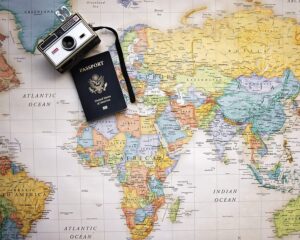Group travel is among the most satisfying ways to create memories with family, friends or colleagues. However, arranging a smooth group excursion requires careful planning, a thoughtful assessment of the needs of all participants and a balanced mix of structure and flexibility. If it’s a getaway with your friends or a comprehensive plan for a trip abroad to make the trip the most enjoyable it can possibly be depends on how the logistics are taken care of. This blog will guide you through the essential steps to make sure your travels with a group are relaxing and enjoyable.
Early Planning Stages
The key to the success of a group trip is in the planning stage. Begin by determining the common goals of the group the trip. Are you looking for relaxation or adventure, cultural exposure or all three? Finding a way to get everyone to agree on a shared purpose and destination in advance can aid in avoiding confusion later. After deciding on the destination it is time to discuss dates for travel that are suitable for the majority of people. Remember that larger groups might require more time to plan ahead for booking accommodations, transportation, and other activities.
Making a budget draft in the initial stages is important. There are many members with different financial limitations, and it’s crucial to find the right balance to ensure everyone’s participation. Setting a budget for the total cost of travel, accommodation food, activities, and meals–gives everyone an opportunity to determine whether the trip is in line to their financial budget. Transparency in this stage will pay off later on.
Coordination and Communication
When it comes to group travel Effective communication is essential. It removes doubt and ensures all participants are on the same team. Begin by naming the two or three individuals who will be the main organizers, to simplify decisions and prevent chaos. These individuals can assume the responsibility of assembling everyone’s inputs and keeping the process in a focused manner.
Make use of technology to facilitate group communications. Tools such as WhatsApp, Slack, or dedicated apps for traveling can make keeping connected a breeze. Create a group chat for your team to communicate updates, ideas deadlines, or even votes for making the making of decisions. Also, keep an open feedback channel to take into account everyone’s opinions and still move the process ahead.
Setting clear guidelines for communication and allowing honest dialogue will help to avoid expectations that aren’t in line. For example, you could accept that any changes to the schedule will be decided on as the group, or you can decide the manner in which payment obligations are handled collectively.
Accommodation and Transportation
The process of finding a suitable accommodation for a group could be complicated, but with initial research, it could be made simpler. Holiday rentals such as Airbnbs or big villas typically offer better value for groups as compared to hotels. They provide shared space for bonding and lowering expenses through sharing of a facility’s facilities. Areas that are close to scheduled events or public transportation hubs help make logistics more efficient. If you are booking, make sure to read reviews and confirm the capacity to ensure that the accommodation is able to accommodate all guests.
There are a variety of options available for transportation depending on the destination and the size of the group. A van rental or charter bus will ensure that everyone is together, which can enhance the overall experience. Additionally, public transportation could be a viable option for those living in cities that are well connected. Whatever the option making reservations ahead of time ensures availability and usually reduces the cost. Make sure you budget for travel to and from airports, excursions and transportation requirements for the last mile.
Activities and Itineraries
Making sure your itinerary is balanced is among the most crucial steps in planning a group trip. While it’s tempting, try to fit everything you can but over-loading the itinerary can cause logistical problems and make everyone exhausted. A planned itinerary gives the structure needed, while also providing free time and spontaneity to explore.
Make sure to include a variety of activities that meet various interests within the group. For instance, if certain members are into outdoor activities while others prefer experiences that are cultural make sure to combine hikes with food tours or museum excursions. Be aware that the flexibility of your plans can be the difference in the experience of a group; not everyone must participate in every single activity. Incorporating optional elements into the itinerary lets participants customize their experience without disrupting the group’s plans.
It is essential to research ahead to ensure a efficient running of your activities. Buy tickets to major attractions to avoid lengthy wait times and make sure your group’s seats are secure. Giving sneak peeks into the program and gaining agreement on the planned activities will help keep the excitement high.
Managing Conflicts and Ensuring Harmony
When traveling with a group, it can lead to conflict or tension. This is normal when you mix diverse personalities, preferences and ways of traveling. But, proactive and preventive strategies can be a big help in resolving conflicts and preserving peace.
Establish clear expectations for the roles, responsibilities, and travel goals in advance. For example, you can decide who makes reservations for meals or who collects tickets for various activities. As much as possible, rotate responsibilities to ensure that no one is being overloaded. Make sure that there is a clear and respectful way to communicate in the event of conflicts, and remind everyone that the aim is to be awed by one another’s company and shared experiences.
Respect for the individual’s preferences is also important. While travelling together can be beneficial but it’s fine to allow members to separate to do their own thing or take smaller group excursions. Allowing everyone to have their own space and flexibility will help to decrease friction and ensure that your excursion is enjoyable for everyone.
Wrapping up Your Group Travel Adventure
A trip with a group is about more than simply visiting an area. It’s about sharing laughs memories, experiences, and stories which bring people closer. Making plans ahead while communicating effectively and being flexible are essential to ensure that your group’s trip is as enjoyable and seamless as is possible.
At the end of your trip Take some time to think about what went well and what didn’t work during the planning and execution process. Get feedback from your group to make improvements for future trips. Don’t forget to acknowledge those who organized or planned your trip and have taken on the task of making your trip successful.
FAQs
1. How long in advance should we begin planning an excursion for the group?
Plan at least 3-6 months ahead of time for domestic travel, and 6-12 months in advance for international travel. Larger groups could require longer lead time to make arrangements.
2. How do you find the most efficient method to divide expenses during the event of a group trip?
Applications such as Splitwise or Venmo can assist in managing shared expenses, while ensuring complete transparency. One person could also manage the expense as it arises, with expenses being split and then paid back later.
3. How do we make sure everyone is happy with the experience?
The group should be surveyed to find out their preferences, make sure that you have a variety of activities and include optional sections in the program to meet the needs of different groups.
4. What happens if someone has to cancel at at the last second?
A cancellation policy in the beginning can be helpful. Also, think about traveling insurance in case of sudden changes.
5. What can we do to ensure a smooth communication during the journey?
Make sure to use your group chat application or group chat to check for information and assistance with troubleshooting. Designate team leaders to handle parts of the plan to reduce confusion.




